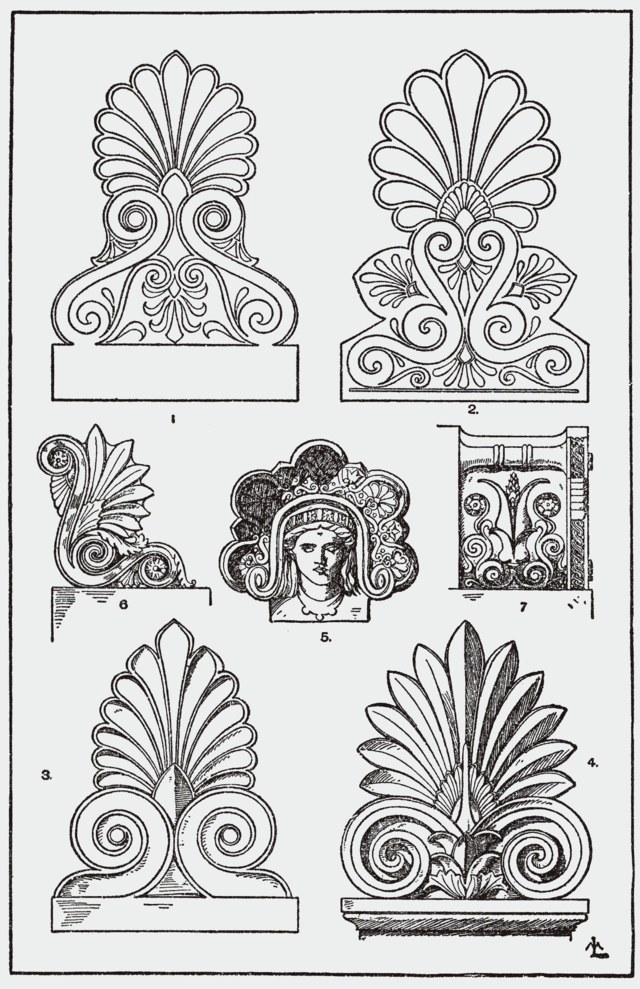Top Qs
Timeline
Chat
Perspective
Acroterion
Architectural ornament of a classical building From Wikipedia, the free encyclopedia
Remove ads
An acroterion or acroterium (pl. akroteria)[1] is an architectural ornament placed on a flat pedestal, the acroter or plinth, and mounted at the apex or corner of the pediment of a building in the classical style.[2] An acroterion placed at the outer angles of the pediment is an acroterion angularium (angulārium means ‘at the corners’).

The acroterion may take a wide variety of forms, such as a statue, tripod, disc, urn, palmette or some other sculpted feature. Acroteria are also found in Gothic architecture.[3] They are sometimes incorporated into furniture designs.[4]
Remove ads
Etymology
The word comes from the Greek akrōtḗrion (ἀκρωτήριον 'summit, extremity'), from the comparative form of the adjective ἄκρος, ("extreme", "endmost") + -τερος (comparative suffix) + -ιον (substantivizing neuter form of adjectival suffix -ιος). It was Latinized by the Romans as acroterium.[5] Akroteria or Acroteria is the plural of both the original Greek[6] and the Latin form.[7]
According to Webb, during the Hellenistic period the winged victory or Nike figure was considered to be "the most appropriate motif for figured akroteria.”[1]
Remove ads
Gallery
- Ancient Greek marble acroterion in the form of Nike, Archaeological Museum of Samothrace, Samothrace, Greece
- Ancient Greek acroterion of a Nereid on horseback, c.380 BC, marble, National Archaeological Museum, Athens
- Ancient Greek akroterion, 350–325 BC, marble, Metropolitan Museum of Art, New York
- Akroterion of the grave monument of Timotheos and Nikon, 350–325 BC, marble, Metropolitan Museum of Art
- Ancient Greek acroteria from a temple of Artemis, 330-300 BC, marble, Archaeological Museum of Epidaurus, Epidaurus, Greece,
- Ancient Greek acroteria of the Tomb III, Agios Athanasios, Greece, 325-300 BC
- Simplified Ancient Greek acroteria of the pediment on an honorary decree, c.300-250 BC, bronze, National Archaeological Museum, Athens[8]
- Romanesque acroterion of the Église Saints-Pierre-et-Paul de Rosheim, Rosheim, France, unknown sculptor or architect, c.1150
- Renaissance acroteria of the Villa La Rotonda, outside Vicenza, Italy, designed by Andrea Palladio, 1566-1590s[9]
- Neoclassical acroteria with mascarons on the Grave of Lupin-Roux family, Loyasse Cemetery, Lyon, sculpted by Pierre-Marie Prost, c.1830
- Neoclassical acroteria of a window of the Großer Blumenberg, Leipzig, Germany, designed by Albert Geutebrück mid-19th century
- Neoclassical pediment with acroteria of the Grave of Alexandrina Grejdanescu and Barbu Grejdanescu, Bellu Cemetery, Bucharest, Romania, unknown architect or sculptor, c.1871
- Japanese acroterion, illustrations by Abel Guérineau, 1887
- Beaux Arts acroterion of the Collège Franklin (Boulevard Louis-XIV no. 5), Lille, France, unknown architect or sculptor, c.1900
- Beaux Arts acroterion above a window of Strada Grigore Cobălcescu no. 14, Bucharest, unknown architect or sculptor, c.1900
- Beaux Arts acroterion above a window of Strada Bocșa no. 2, Bucharest, unknown architect or sculptor, c.1900
- Art Nouveau acroterion of a stove in the Mița the Cyclist House (Strada Biserica Amzei no. 9), Bucharest, possibly designed by Nicolae C. Mihăescu,[10] 1908
- Art Deco acroterion of the Dinicu Golescu Entrance of the Northern Railway Station, Bucharest, designed by Victor Gh. Ștephănescu, 1935[11]
- Postmodern acroterion of the Harold Washington Library, Chicago, by Hammond, Beeby & Babka, 1991[12]
- Postmodern acroteria on the pediment of the Children's Museum of Houston, Houston, US, by Robert Venturi, 1992[13]
- New Classical acroteria on the pediment of the Maitland Robinson Library, Downing College, Cambridge University, Cambridge, UK, by Quinlan Terry, 1992
Remove ads
See also
References
Further reading
External links
Wikiwand - on
Seamless Wikipedia browsing. On steroids.
Remove ads






















